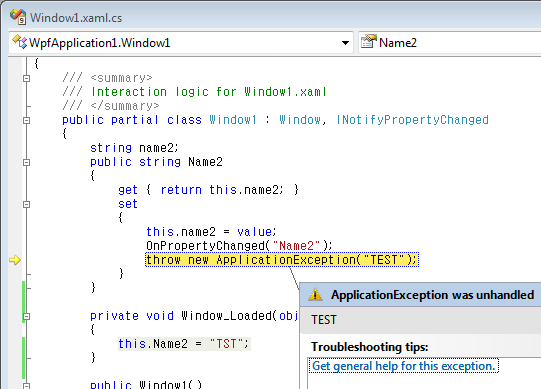336x280(권장), 300x250(권장), 250x250, 200x200 크기의 광고 코드만 넣을 수 있습니다.
未处理 System.InvalidOperationException
Message=无法关闭撤消单元,因为不存在已打开的单元。
Source=PresentationFramework
StackTrace:
在 MS.Internal.Documents.UndoManager.Close(IParentUndoUnit unit, UndoCloseAction closeAction)
在 System.Windows.Documents.ImmComposition.CloseCompositionUndoUnit(UndoCloseAction undoCloseAction, ITextPointer compositionEnd)
在 System.Windows.Documents.ImmComposition.UpdateCompositionText(FrameworkTextComposition composition, Int32 resultLength, Boolean includeResultText, ITextPointer& start, ITextPointer& end)
在 System.Windows.Documents.ImmComposition.RaiseTextInputStartEvent(FrameworkTextComposition composition, Int32 resultLength, String compositionString)
在 System.Windows.Documents.ImmComposition.OnWmImeChar(IntPtr wParam, Boolean& handled)
在 System.Windows.Documents.ImmComposition.ImmCompositionFilterMessage(IntPtr hwnd, Int32 msg, IntPtr wParam, IntPtr lParam, Boolean& handled)
在 System.Windows.Interop.HwndSource.PublicHooksFilterMessage(IntPtr hwnd, Int32 msg, IntPtr wParam, IntPtr lParam, Boolean& handled)
在 MS.Win32.HwndWrapper.WndProc(IntPtr hwnd, Int32 msg, IntPtr wParam, IntPtr lParam, Boolean& handled)
在 MS.Win32.HwndSubclass.DispatcherCallbackOperation(Object o)
在 System.Windows.Threading.ExceptionWrapper.InternalRealCall(Delegate callback, Object args, Int32 numArgs)
在 MS.Internal.Threading.ExceptionFilterHelper.TryCatchWhen(Object source, Delegate method, Object args, Int32 numArgs, Delegate catchHandler)
在 System.Windows.Threading.Dispatcher.InvokeImpl(DispatcherPriority priority, TimeSpan timeout, Delegate method, Object args, Int32 numArgs)
在 MS.Win32.HwndSubclass.SubclassWndProc(IntPtr hwnd, Int32 msg, IntPtr wParam, IntPtr lParam)
在 MS.Win32.UnsafeNativeMethods.CallWindowProc(IntPtr wndProc, IntPtr hWnd, Int32 msg, IntPtr wParam, IntPtr lParam)
在 MS.Win32.HwndSubclass.DefWndProcWrapper(IntPtr hwnd, Int32 msg, IntPtr wParam, IntPtr lParam)
在 MS.Win32.UnsafeNativeMethods.CallWindowProc(IntPtr wndProc, IntPtr hWnd, Int32 msg, IntPtr wParam, IntPtr lParam)
在 MS.Win32.HwndSubclass.SubclassWndProc(IntPtr hwnd, Int32 msg, IntPtr wParam, IntPtr lParam)
在 MS.Win32.UnsafeNativeMethods.DispatchMessage(MSG& msg)
在 System.Windows.Threading.Dispatcher.PushFrameImpl(DispatcherFrame frame)
在 System.Windows.Threading.Dispatcher.PushFrame(DispatcherFrame frame)
在 System.Windows.Application.RunDispatcher(Object ignore)
在 System.Windows.Application.RunInternal(Window window)
在 System.Windows.Application.Run(Window window)
在 System.Windows.Application.Run()
在 LiveChainCHIS_Client.App.Main() 位置 D:\项目\LiveChainCHIS-Client\LiveChainCHIS-Client\obj\x86\Debug\App.g.cs:行号 0
在 System.AppDomain._nExecuteAssembly(RuntimeAssembly assembly, String[] args)
在 System.AppDomain.ExecuteAssembly(String assemblyFile, Evidence assemblySecurity, String[] args)
在 Microsoft.VisualStudio.HostingProcess.HostProc.RunUsersAssembly()
在 System.Threading.ThreadHelper.ThreadStart_Context(Object state)
在 System.Threading.ExecutionContext.Run(ExecutionContext executionContext, ContextCallback callback, Object state, Boolean ignoreSyncCtx)
在 System.Threading.ExecutionContext.Run(ExecutionContext executionContext, ContextCallback callback, Object state)
在 System.Threading.ThreadHelper.ThreadStart()
InnerException:
补充说明一下 ,这个错误只出现于 数据绑定后的TextBox控件上。
解决办法: 设置Textbox的UndoLimit 为0就ok。
중문 윈도우에서 중문 IME를 이용해 TextBox에 글자를 입력하려고 하면 발생하는 예외 처리 방법
위에 써있듯이 TextBox에 UndoLimit을 0으로 설정해주면 해결된다
출처 : http://www.cnblogs.com/muzizongheng/p/3169812.html




